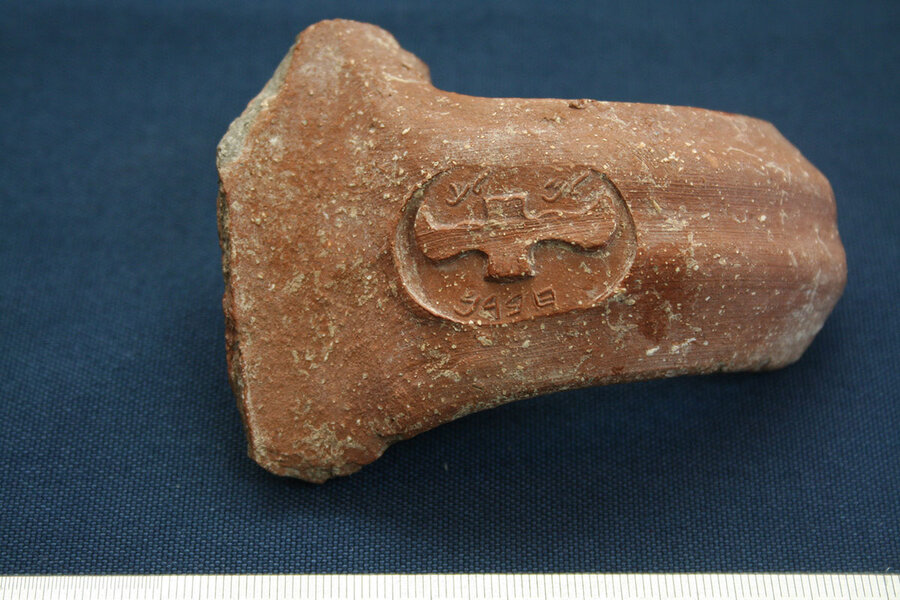What ancient clay jugs reveals about Earth's magnetic field
Loading...
If anyone in the Near East had owned smartphones 2,700 years ago, they might have noticed something very weird.
Though compasses seem pretty steady, the orientation and strength of the Earth’s magnetic field vary sharply over time, sometimes shifting in the geological blink of an eye. A new study took advantage of conveniently time-stamped clay pots to create the most detailed reconstruction of the historical magnetic field yet, revealing some mysterious behaviors.
Direct measurements of this vital planetary shield date back almost two centuries, during which time we’ve seen the field weaken by about 10 percent, prompting some scientists to wonder if we’re at the beginning of a periodic flip, where north becomes south and south becomes north.
Other recent reminders of the field’s dynamic nature include the magnetic north pole wandering over 900 miles since 1990, and at least four “geomagnetic jerks” within the last fifty years, where the field’s rate of change jumped suddenly before returning to normal.
At the opposite time extreme from these very-short-term jerks are the multi-million year trends recorded in the ocean floor. Scientists can study fossilized remnants of the magnetic field at the bottom of the sea, thanks to iron-laden minerals that line up with the field when molten, and get locked into that orientation upon cooling. Those deep-underwater records show evidence of pole-flips going back about 175 million years.
But intermediate trends are harder to observe. Fortunately, the kings of ancient Judah have come to the rescue. In their efforts to keep accurate records for tax collection, they inadvertently left us magnetic records – baked into ceramics.
Fired clay pots, like seafloor lava vents, preserve a record of the magnetic field as they cool.
While most ancient pottery pieces are hard to date, a number of jugs found near Jerusalem bear administrative stamps on their handles that can be referenced against the historical record from the 8th to 2nd century BC.
"This was the system of the king in Jerusalem to be able to collect tax efficiently," study author Erez Ben-Yosef, an archaeologist at Tel Aviv University, told Live Science. "We are actually benefiting from a good bureaucratic system, the ancient IRS.”
Thanks to this historical accident, the team assembled what they call an “unparalleled record of the geomagnetic field intensity.” (Intensity, but not direction, since no one knows which way the pots were facing when fired.)
"Our research shows that the field is very fluctuating," Dr. Ben-Yosef told Live Science. They identified a 50 percent spike in the late 8th century BC bringing the field to almost twice what it is today, after which it rapidly lost almost a third of its strength in just over three decades.
The ancient Judeans probably didn’t bat an eye, but such a fluctuation would wreak havoc on our modern satellites and electronics.
However, Ben-Yosef sees good news in this new understanding of our unexpectedly active magnetosphere.
"It fluctuates quite rapidly, so there is nothing to worry about," he explained to Live Science. With jumps and falls in the 30 to 50 percent range, our recent 10 percent decline may not necessarily indicate an imminent pole reversal, and the danger that would entail.
So what is the magnetic field, anyway?
The Earth’s magnetic field has helped sailors navigate for centuries, and protected life from harsh cosmic radiation for billions of years, but key mysteries still surround it.
Scientific consensus says that liquid iron currents turn the planet’s outer core into a kind of electromagnet, generating a field that starts from the center of the Earth and extends hundreds of thousands of miles into space.
But much is unknown about the precise fluid dynamics that create the field, and the results of this study pose new questions.
If correct, the intensity of the Judean spike pushes the boundaries of what some geophysical models predict the Earth should be capable of, suggesting those models may need an update.
In fact, most science disciplines would benefit from a better understanding of this literally global phenomenon, and any capacity to predict future field fluctuations could help scientists and engineers protect our intricate communications infrastructure.
"This is related to various different phenomena, from biology, Earth sciences, geophysics, atmospheric sciences and archaeology," Ben-Yosef told Live Science.






